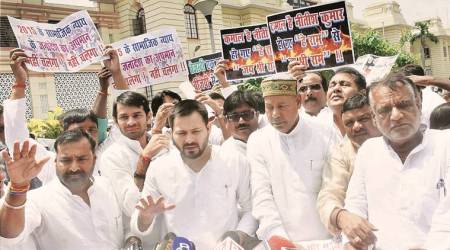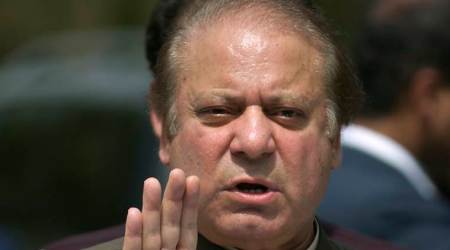 While farmers complain of non-transparency in the manner of price fixation, traders blame the flawed agricultural marketing mechanism for low prices. AP
While farmers complain of non-transparency in the manner of price fixation, traders blame the flawed agricultural marketing mechanism for low prices. AP
A RECENT WhatsApp message doing the rounds, taking a dig at the astronomical prices of tomatoes, is in very poor taste, feels Deepak Bhise. Head of the tomato growers’ association of Junnar taluka in Pune, Bhise says the prices of Rs 40-55 per kg in Pune’s wholesale markets is only a few weeks old. “Since January, we have been forced to sell tomatoes at throwaway prices of Rs 5 or Rs 6 per kg. Why were people silent then,” he asks.
Bhise’s is an argument shared by onion growers too — the media attention from cities when prices hit a high is always annoying for farmers who have to also deal with seasons when prices crash, causing deep losses for agrarian communities. “A bumper crop will arrive soon in the markets, prices will plummet and farmers will again have to bear losses. But then there would be no talk about low prices — the farmer is just not considered part of the system,” says the young farmer.
That anger finds resonance among farmers across the state who have been complaining about low price realisation for years now. The problem is acute in the case of fruits and vegetables. Onion, of course, has experienced the most volatility.
Since January this year, the modal price — the average price at which the commodity is traded — at the Lasalgaon market has been below the psychological mark of Rs 900 per quintal. While consumers have been able to purchase the bulb at a comfortable price of Rs 11-15 per kg, the low prices have led to a long spell of losses for farmers. Santosh Gorade, an onion grower, estimates that the input cost for a kg of onion is around Rs 8.50. For the last few days, onion prices have firmed up to Rs 12.50 per kg, which again has again attracted the attention of the planters. This price rise, according to Lasalgaon wholesale market chairman Jaydutt Holkar, is because of the demand from other states.
Farmers, however, are cautious about the price rise. Gorade points out how they have been forced to sell at prices of Rs 5-6 per kg till date. “Most of us are in losses over the last 15 months,” he says.
Like Bhise, Gorade too points to the silence of the media and urban people when it comes to the plight of growers who are left at the mercy of traders when it comes to prices. While farmers complain of non-transparency in the manner of price fixation, traders blame the flawed agricultural marketing mechanism for low prices. Both, however, are unanimous that agricultural marketing needs major changes to help farmers realise better prices.
The Maharashtra government last year initiated the first round of reforms in agricultural marketing. More are to follow, this time in consultation with the Niti Aayog. Having already permitted vegetables to be sold outside agricultural produce market committees (APMCs), the government will reportedly also make efforts towards de-linking foodgrain from the trader-controlled APMCs. Farmers and farmer leaders have agreed that a wider network of direct linkages between consumers and farmers would be desirable for better profits for farmers.
Post the first reforms, the state government has now pushed farmer producer companies (FPC) as well as farmers’ groups to take up direct selling of fruits and vegetables in urban centres such as Pune, Mumbai, Nagpur, etc. Also, weekly farmers’ markets in line with village markets have also started in some cities to allow the farmers’ groups to undertake direct sales.
There are now 83 such markets functional, with a weekly turnover pegged at more than Rs 5 crore. In tune with their village fare, these markets are held on fixed days at specified places. Tushar Agarwal, director of the Swami Samarath FPC, says such markets offer alternative marketing platforms to farmers. However, he says, there is a need to re-examine the way marketing is done for these initiatives. “At present the focus in on the urban markets to popularise these markets. However much work is needed to attract farmers to participate in such markets,” says Agarwal. Pointing to the case of such markets closing down intermittently, he says proper surveys should be done before opening such markets.
The challenge, say state economists, is the fine line between fair price realisation for farmers and keeping food inflation down at the consumer level. However, farmers say their losses are not taken into consideration while planning. Nanasaheb Patil, director of the Lasalagon wholesale market, points out how the country for the last few financial quarters has reported negative inflation. “That is mostly due to the fall in prices of agricultural commodities,” he says.
The rot in the system, says Patil, is deep and needs urgent rethinking on the part of the government. “The growth in area of horticulture is mostly due to low price realisations of cereals, pulses and oilseeds. As India is not self-sufficient in these commodities, we need to rely on imports. This tends to subdue the domestic prices and farmers wean away from those commodities,” he says. Patil suggests a long-term policy intervention that will allow for dynamic changes in the export-import policy to lure farmers away from horticulture crops.
The kharif season of 2017-18 has been a challenging one. While rains have been bountiful but erratic, farmers have been hit by the collapse of the organised credit structure, a situation that they say will increase their indebtedness.
As of July 15, 2017, banks in the state have disbursed only Rs 11,802.39 crore by way of crop loans. This is just 29 per cent of the kharif season credit target of Rs 40,547.20 crore set for banks earlier in the year. Last year, on the same date, banks had disbursed Rs 23,793.66 crore of the Rs 37,677.03 crores kharif target — a 63 per cent disbursal.
The low credit inflow, however, has not hit sowing and Maharashtra has reported above 80 per cent sowing. As of July 21 this year, 1,19,34,780 hectares of farmland has reported sowing as against 1,17,26,392 hectares reported last year on the same day. Barring a dip in area of tur, moong, and some oilseeds, almost all other crops have reported an increase in area.
The financially weak district central cooperative banks (DCCBs) have till now fared best in terms of loan disbursal. Of their target of Rs 13,108.38 crore, these primarily rural banks recorded 47 per cent disbursal (Rs 6,201.76 crore). The scheduled commercial banks, regional banks and commercial banks have met just about 20, 13 and 21 per cent, respectively. Last year, DCCBs had disbursed 85 per cent of their target, while scheduled commercial, rural and commercial banks had reported 52 per cent disbursal each. DCCBs normally disburse 40 per cent of the crop loans in the state but cater to a larger chunk of farmers.

